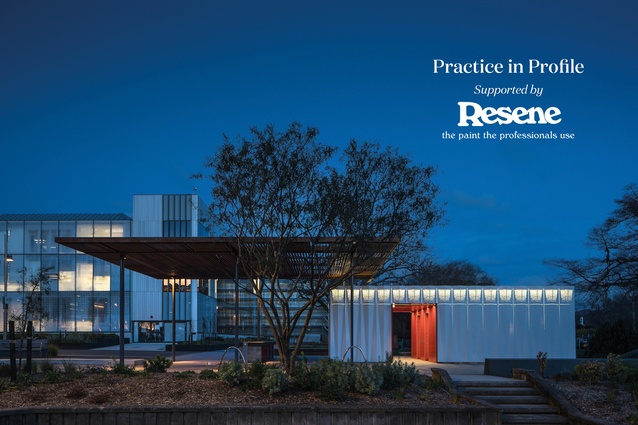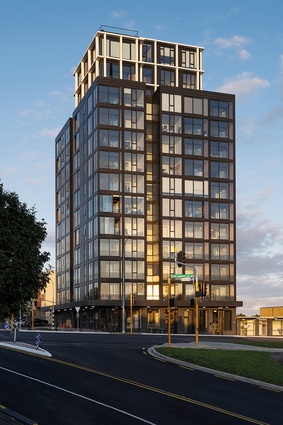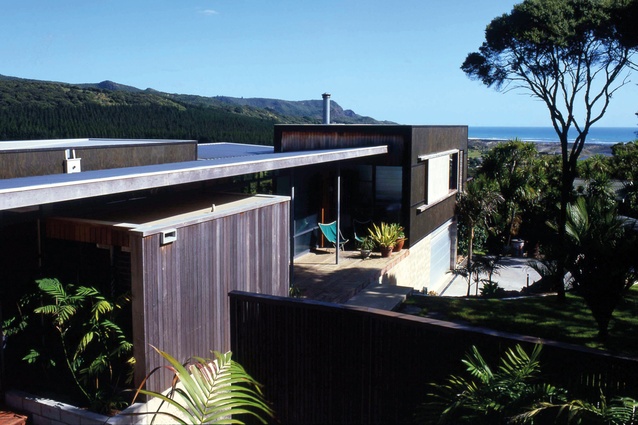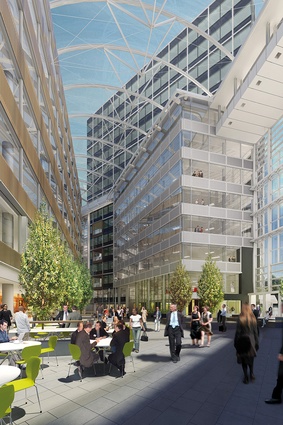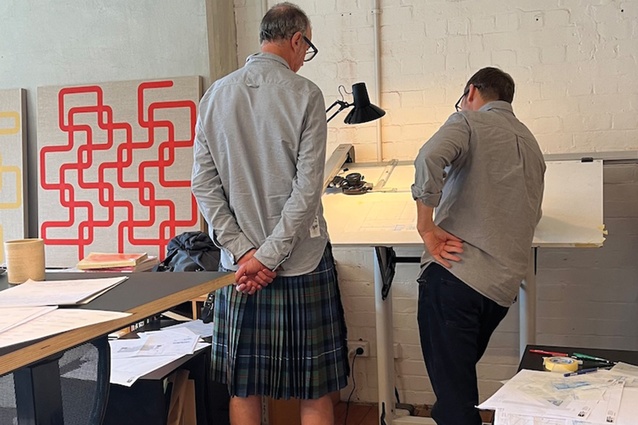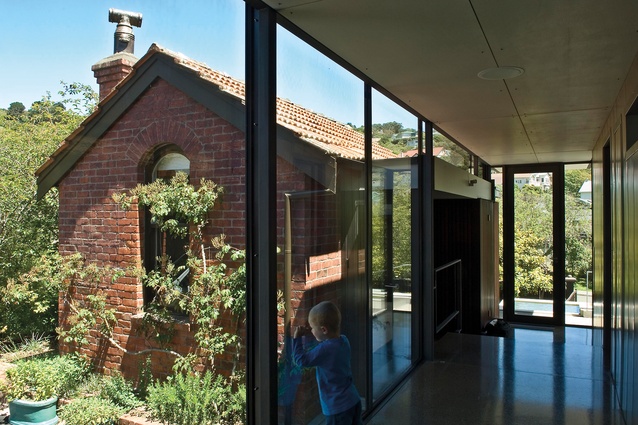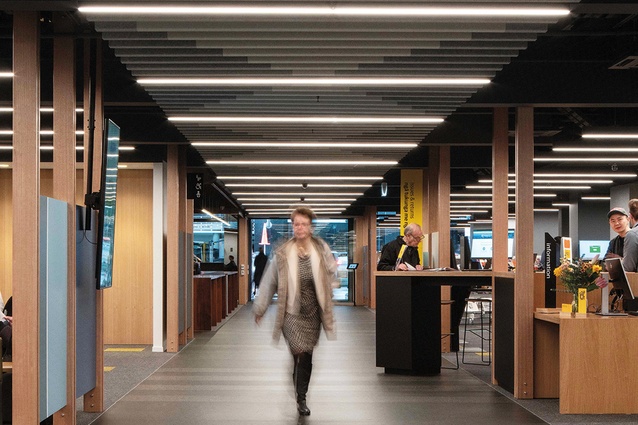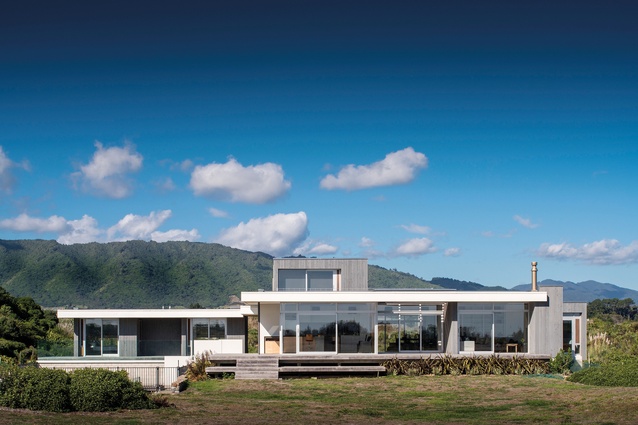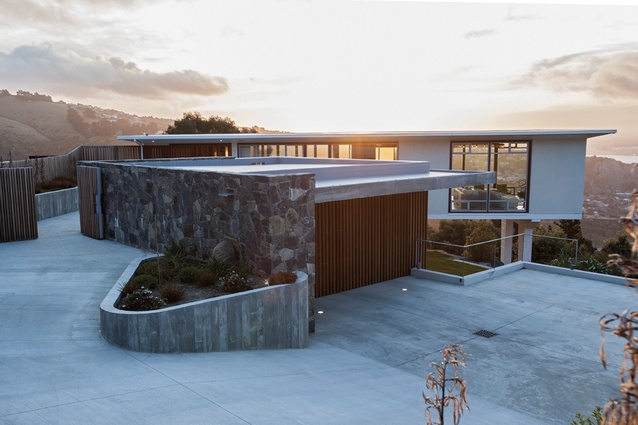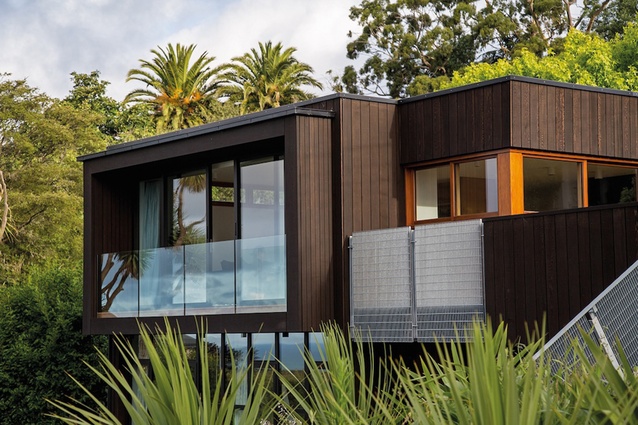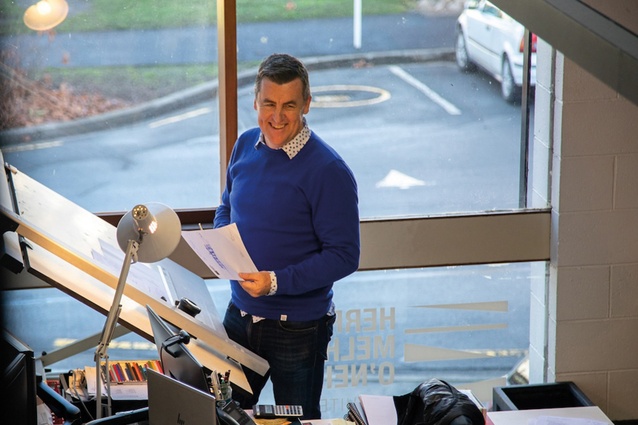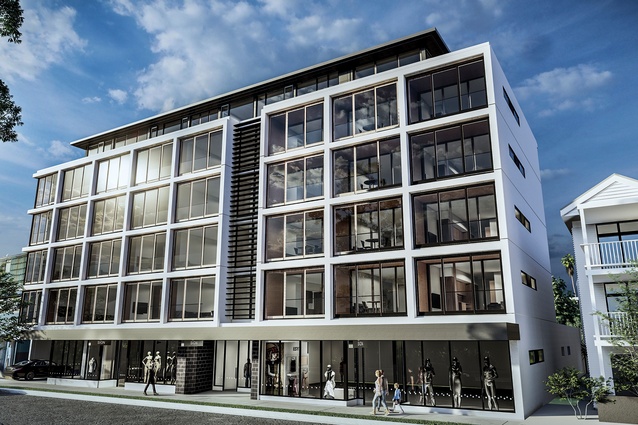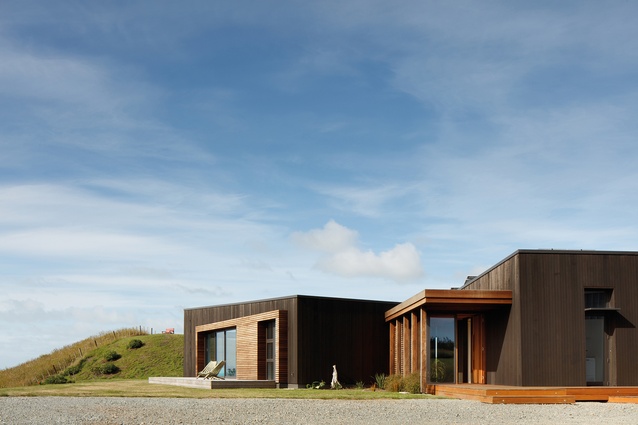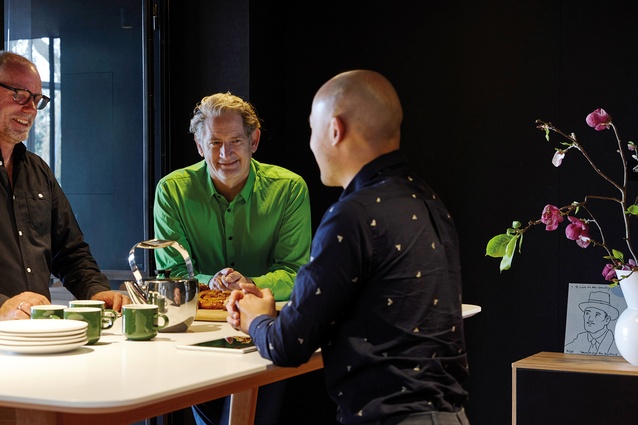Simple and pure
HMOA’s founding directors consider the evolution of the practice over the past 26 years, its unapologetically modernist approach and the importance of relationships, resilience and respect.
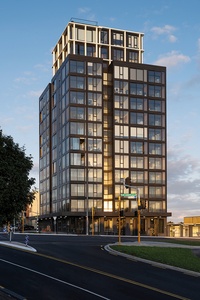
HMOA began in Wellington in 1997 as HMA, Herriot + Melhuish Architecture, founded by Max Herriot and John Melhuish. They were friends and flatmates: John left a decade at Athfield Architects while Max already had his own business, Max Herriot Design. Duval O’Neill joined HMA in 2002 and, in 2005, he moved to Christchurch to establish an HMA studio there. Duval became a director in 2007, and HMA became HMOA.
The Tāmaki Makaurau studio came about when architect and property investor Matt Pearson answered HMOA’s ad on the NZIA website. Matt opened the Parnell studio in 2016, with Matt Robinson joining him as co-director in 2022.
Here, the founding directors of HMOA’s three studios reflect on their business.
MAX HERRIOT, WELLINGTON STUDIO
John says he took nine months to commit to going into business with me but I remember it as much less. I saw us as two like-minded people on a similar level; I might have had more initial contacts that led to the early jobs but John had more commercial experience than I did.
John and I are both pretty pragmatic and practical, and we often come up with the same approach. We work on projects together but everything is the output of the practice. It’s never been the case that one director has brought in a lot more work than another.
We are both modernists; we like things simple and pure, and there’s a practicality in that. We collaborate on design but we don’t get entrenched in it — I enjoy the early stages, the broad thinking and then I like to move on without getting too much into the detail; maybe that’s partly my personality.
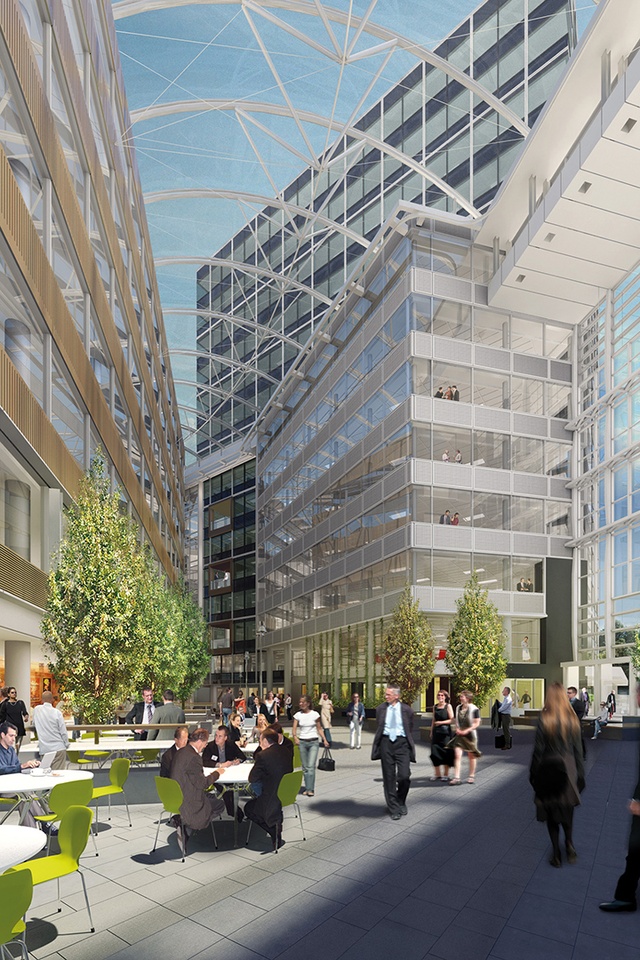
I look back and can see the waves; 2006–2008 was a great time. We were working on the Bowen project, the largest commercial development in the country back then, and it was rewarding, finally, to have that opportunity. When that died, it was a difficult period of five or six years. Working that hard for no real financial gain was challenging. Since then, we’ve had a fairly good run, although it’s a bit quiet at the moment. You have to grind it out through the tough times. Keeping going in business is harder as you grow older but you also know you’ve been through it before and will regain confidence.
Success for me is creating a great work culture with people who work as a team and stick around for an extended period — and have a sense of humour; that’s what keeps me coming into work. The catch-ups with our other studios extend that culture. We’ve employed more than 70 people and I’d like to think most of them have had a good experience.
Employing people is a natural pull. It’s all about relationships. Bringing in new directors is about finding people who have the ability to secure new work. It’s all part of creating a network and broadening the base of the HMOA culture. Introducing Duval as a director and, more recently, Matt setting up the Auckland studio have been fantastic for the practice. All our directors get on really well and that’s gratifying.
I think the depth of New Zealand architecture has expanded over the last 20 or 30 years; it’s more competitive and there’s more money committed to architectural projects. I admit I prefer the commercial to the residential projects now. Residential work used to motivate me but the challenge of the commercial projects is more engaging to me these days.
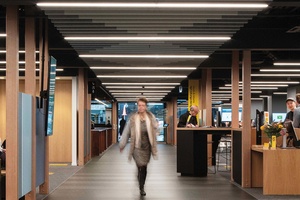
I particularly enjoyed working on the Harbour City Centre redevelopment. The 7000m² heritage-listed building stretches a city block in Wellington’s CBD. As well as strengthening the building to 100 per cent, the project involved completely refurbishing the interior and exterior, and maintaining the building’s heritage values, including the existing leadlight and steel windows. We inserted a modern, glazed box into the top floor, with roof terraces to the north and south, and a grand, contemporary staircase into the core of the building. A new light-well floods natural light throughout. The staircase balustrade is clad in black steel, with the floor spandrels in timber panels. These finishes are carried into our fit-out for the building’s tenant, FNZ. Both the FNZ and Te Awe Library fit-outs on the ground floor were integrated into the strengthening and refurbishment programme.
It’s unfortunate that only a small percentage of New Zealand buildings are designed by reputable architects. People don’t understand the influence a good architect can have on the urban environment and the key decisions that hugely influence all our lives. Maybe it’s time we architects engaged in a bit of protest — go and chain ourselves to the gates next time the bulldozers are coming in for another suburban-sprawl-type subdivision.
Music picks: Others control the music in the office. Out of work, I still love Radio Active. There’s a music revolution every day and life’s too short to be too nostalgic about music.
Stress-busters: Biking. I’m over doing events but I still bike to work most days and go out for a run a couple of times a week. I got into cold swimming on a trip to Scandinavia earlier in the year. Now I have a cold shower every day.
JOHN MELHUISH, WELLINGTON STUDIO
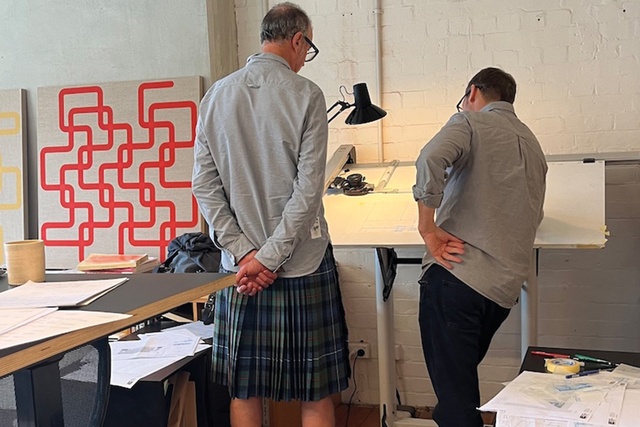
Architecture is a complex and difficult profession and the rewards cannot be just pecuniary. Having good people around me, a business partner like Max, later Duval and now the Matts, plays a big part in how I’ve stuck it out. Max and I share interests and curiosities, and like talking about design and problem-solving. There’s a mutual respect. It’s a high-trust and rewarding relationship with all the directors. We’re also very fortunate to have Associate Stephanie Gardner in the Wellington studio; she’s been a key part of HMOA for 18 years.
I still carry the influences of working for Ath — the inclusive culture and intoxicating connection between life and architecture, albeit during a time in my life when I had neither family nor mortgage. It was a sharing, collaborative and sometimes chaotic environment. I also experienced the incredible ebbs and flows of our industry, which has made me more pragmatic about the ups and downs in our own practice. I go back to those influences and culture as an aspiration, although I’m only one voice at HMOA now.
I’ve always felt slightly uncomfortable trying to sum up our approach to design but I would describe HMOA directors as unapologetic modernists — perhaps a reaction against some of the ’70s and ’80s postmodernism. We prefer a rational, honest, predominantly orthogonal and, at times, minimalist approach to composition. Other than pure circles, you won’t see any curves or 45-degree angles in our projects.
I enjoy the intellectual challenges of architecture and I love the physical act of drawing and of thinking while I’m drawing, and the different strategies of design that using a pencil entails. We’re always trying to encourage drawing in our practice and I think that losing this skill, with its associated deep thought and analysis, is detrimental to our industry. All the digital technology and, now, AI are presented as ways of becoming quicker and more efficient. Although they’re helpful in researching, documenting and managing information, we’re at risk of being distracted from what we, as architects, should be focused on.
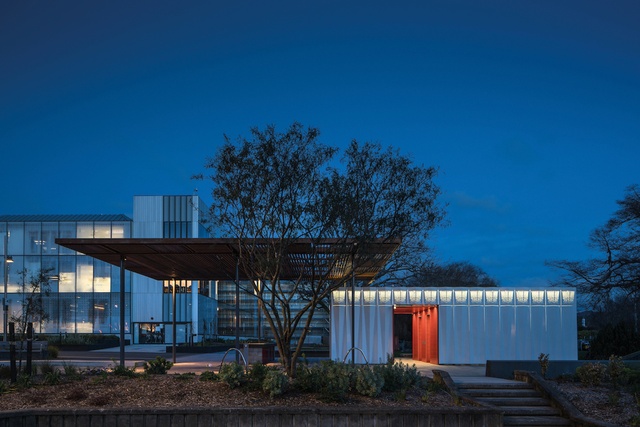
Without picking any favourites, Silverscreen/ Oktober, Wellington and Auckland, were seminal projects for us and, weirdly, we’re working on Wellington again for the China Cultural Centre. Riddiford Pavilion was great — I have always considered public toilets to be an under-considered close connection between the craft of design and humanity. Te Awe Library was also a very rewarding public project. With supportive clients and the skills of LT McGuinness, we squeezed the best out of a very challenging space to create a generous and welcoming hub for Wellington. Creating an internal laneway between the two streets became an obvious axial focus for the planning and navigation. We have also been working on some interesting projects for the film industry. Lane Street Studios in Upper Hutt was completed last year.
Over the years, my sensitivity to difficult situations and people has become more acute. But, I’m also more philosophical about what life brings and what we’re trying to achieve.
During recessionary times, we’re forced to question some of the projects and clients we take on, and make compromises, but that’s just the nature of the sector. Having studios in other centres has been a good decision for resilience during these times. Setting up the new practice in Auckland as we did was an unusual situation and we were fortunate that Matt Pearson saw our ad. He’s lived on both sides of the fence, as client and architect, so that’s brought new insights to what we do.
We’re all aware we don’t have much diversity in our leadership team and will continue to try to change that. There’s also that constant nagging question: why would you want to be the director of an architecture firm?
Music picks: At the drawing board: Nils Frahm, Biosphere, Carbon Based Lifeforms and Alargo. At the computer: anything that wouldn’t be played on commercial radio.
Stress-busters: Trail-running in the mud and mountains, and surfing. In futile defiance of aging, I do the occasional trail ultra-event.
DUVAL O’NEILL, CHRISTCHURCH STUDIO
When Bridget and I decided to move south, John and Max were a sounding board. That’s how the idea came about to give it a go and set up a Christchurch office. I was relieved; I knew I was with the right people. The relationship shifted from employee to business partner to good friends.
You get longevity in your business relationships only if you respect the people you’re working with, and I really respect what John and Max have achieved and the opportunities we’ve built together.
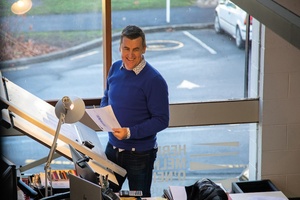
Ian Athfield kindly let me share some space in his Christchurch office — initially, it was me and a bunch of blokes listening to the cricket. I then moved upstairs and eventually got our first Christchurch jobs. Because I was the new kid, there were a few rogues to navigate through first.
Athfields stopped me going crazy in the attic and I even picked up projects through referrals from them, including Clifton Hill House. You can’t underestimate how useful those breaks were. One network feeds off another and, when we bought a small modernist house in Mount Pleasant, John Vial of Vial & Bellerby Architects, a friend of Ath’s and a huge support to me, said it was designed in the 1950s by local architect, Don Cowey. That’s how I met and became friends with Don and his wife Jocelyn. No one could have foreseen the tragic events that were to come — Don lost his life in the 2011 February earthquake. Our house faired reasonably well; however, it was deemed uneconomic to repair.
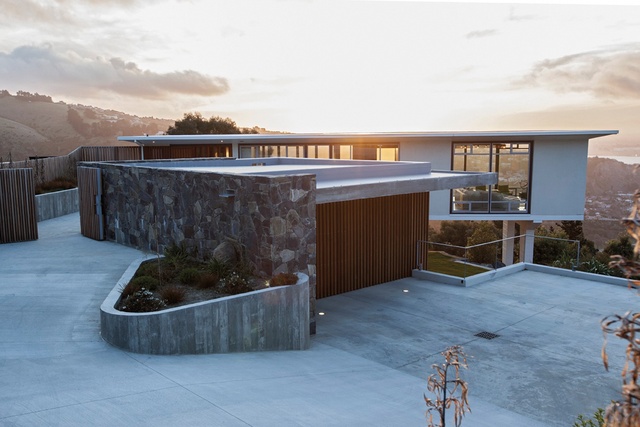
Rebuilding it was a tribute to Don, with the design strategy largely to maintain the essence of his original design while taking the opportunity to adapt it to more modern living. In many ways, the project was an alteration: the restriction being the original house, the opportunity being the unique solutions that arose from working within those restraints. The material palette remains the same as Don originally detailed it — simple, natural and with lots of wood. The original double-skin cladding has also been maintained, articulating each elevation in dark Western red cedar or Siberian larch. I think Don would have approved; he was a modernist architect and a generous man, and he would have embraced it and the fact that we’ve since done work for his son and, now, his granddaughter.
Nothing’s guaranteed in this industry; the phone rings and a project goes on hold. It’s hard to hold your nerve when you don’t know where the bottom is. We’ve learnt to cherish the work we have and do it well, and then we’ll get that next job. The diversity of our projects also gives us resilience. Being involved in rebuilding the city post the earthquakes has given architecture an extra sense of purpose.
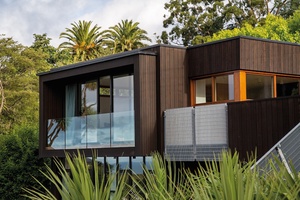
We’re fortunate to have Nic Sewell, who is on the path to becoming a director in the Christchurch studio — it’s so important to have continuity. It’s not about having your own stamp on everything — letting go of some of the responsibility is liberating. You see the growth in that new person and it’s rewarding.
Residential architecture is now very competitive and flooded with non-architects. It’s so fashionable and consumable — people are changing their benchtops like they change their carpet. Gone are the days when a house is loved and cared for over a lifetime. It’s particularly hard to find mid-century houses, one of our specialities, that haven’t been messed with.
What distinguishes an architect’s work is a level of clarity, detail and consistency. You see it in our joinery: another way we’re trying to craft space. There’s not a great deal of maturity in New Zealand for understanding what an architect does but, when we’ve taken a project the whole way through, our clients get it.
I feel a responsibility to train graduates so they gain the experience needed to become good architects as quickly as they can. We foster a studio where everyone is listening to everyone else. It might get a bit frenetic but it’s important to know what’s going on. Christchurch is a natural extension of the Wellington culture. It’s not hierarchal; there’s a sense of mentoring.
We still make models and draw, and it’s refreshing to see those skills coming back. The last thing we want to see is buildings that look like Revit models. I’ve had an interest in drawing since I was young. I was taught life drawing at architecture school by Pat Hanly and Claudia Pond-Eyley and I’ll never forget that.
Music: Flying Nun.
Stress-busters: Mountain biking — it’s fundamental to washing away what’s gone on during the week. I also like building stuff (it stems from being a builder’s son), fishing and skiing. One of the major reasons we moved south is it’s a big playground.
MATT PEARSON, AUCKLAND STUDIO
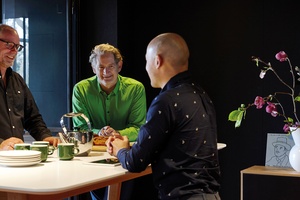
I already had a few jobs on the books when I saw HMOA’s ad for someone to establish an Auckland office. I contacted John, who struck me as a person who knew how to have the direct conversations. I wanted the camaraderie of having people to bounce ideas off and to know how to work better with clients. I was interested in learning from colleagues experienced in managing a larger firm. I wanted to become a better architect.
I’m quite slow to commit to people and, in the early days of talking to John, Max and Duval, we tried each other out first by working on a couple of jobs I had on — we had nothing to lose in giving it a go. Once we committed, John or Max would fly up every second week.
Having experience as a builder of my own investment properties puts me in a better position as an architect to pitch for commercial projects. I understand the importance of having the right team around you, picking the best people, because you’re going to be working with them for the next two or three years. You need people who know how to respond to problems throughout the construction period.
It’s useful for architects to understand what developers are dealing with and know what the client can afford. I also understand how frustrated clients get with some consultants, and how much more money, time and interest they can cost them towards the end of the construction phase.
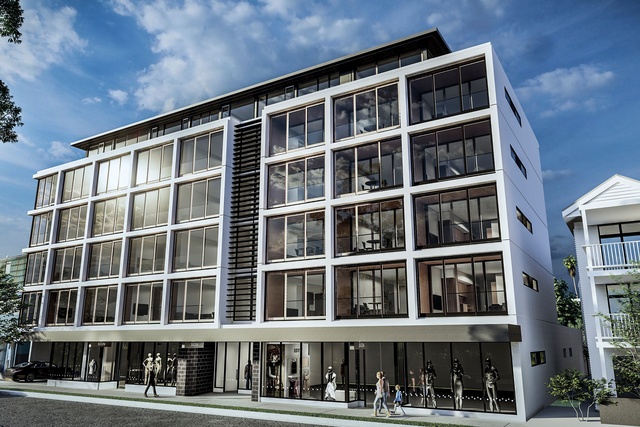
I’m attracted to the bigger jobs where the challenge is to make it all add up. How do we achieve the yield yet still design spaces that people will love to live or work in? We’re currently working on several apartment developments, including Rose Road Apartments, a build-to-rent project in Ponsonby, which is almost complete. Buscomb Avenue Apartments was completed last year: one and two-bedroom apartments as part of the KiwiBuild scheme, and two and four-bedroom options for the open market. We’re also interested in urban renewal projects and are still enjoying the new stand-alone residential projects.
I’m proud to be part of HMOA and its long heritage. Matt Robinson is a fantastic co-director and has been invaluable in the last few years during Covid – dealing with lockdowns and keeping everyone going. For me, the key to staying in business is supportive colleagues and bloody-mindedness.
Music: Spotify categorises my music taste as ‘Throwback Alt Rock and Emo/Screamo’.
Stress-busters: Squad training at the Newmarket Pool for upcoming ocean swimming events like Rangitoto to St Heliers. Shuttle mountain biking with friends in Rotorua.

HMOA’s portfolio extends across residential and commercial — education, recreation, film, heritage, health and hospitality sectors, multi-unit, civil projects, commercial interiors, strengthening and master-planning. All directors are advocates for their industry, and Duval O’Neill and John Melhuish have regularly served on awards juries and industry boards; John is an NZIA Fellow. HMOA belongs to the New Zealand Green Building Council and is Homestar accredited.


